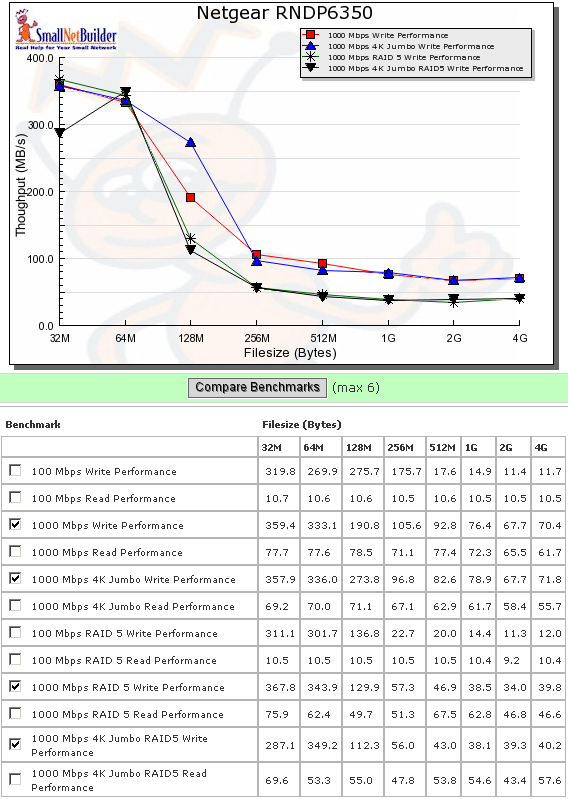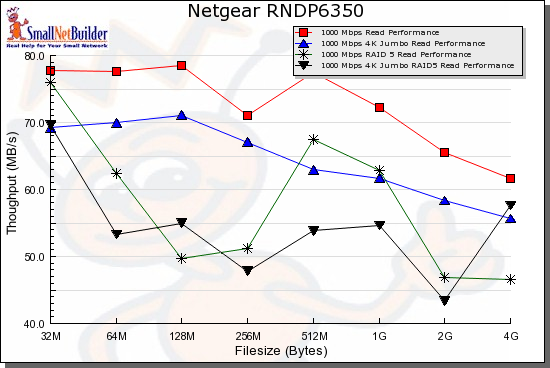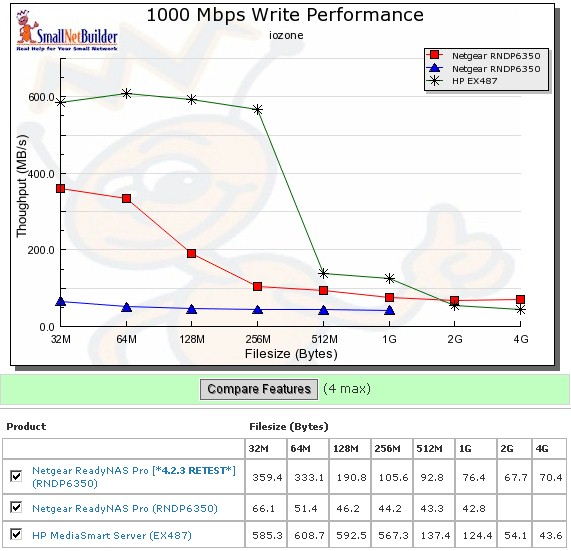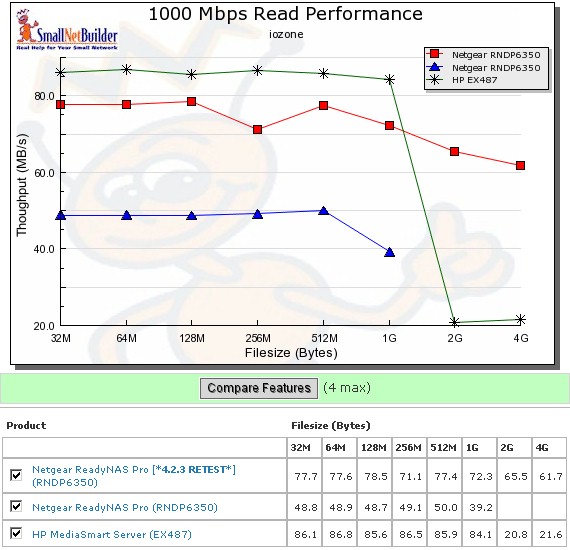The high performance of NETGEAR’s top-of-the line ReadyNAS Pro series was one of the reasons behind the revamp of our NAS test procedures. So the ReadyNAS Pro was one of the first NASes that I retested with the new test bed.
NETGEAR, however, had some additional performance tweaking to do, which has been incorporated into its just-released 4.2.3 firmware. So I once again put the Pro through RAID 0 and RAID 5 tests to see how it did.
First a few test notes. The system tested was a three-drive RNDP6350, the same system I reviewed last November. I tested it with the three drives configured in "Flex RAID", i.e. standard RAID, in RAID 0 and 5 modes. I departed from my standard practice of testing product in its default settings, i.e. NETGEAR’s proprietary X-RAID2 system, so that I could include it in the RAID 5 NAS Charts.
Since I was departing from standard practice, I also granted NETGEAR’s request to disable all journaling and to enable fast CIFS writes to optimize performance. I tested with 100 Mbps, 1000 Mbps and 1000 Mbps with 4k jumbo frame LAN connections.
The new test method has been causing some confusion because the 2 GB of RAM in the testbed machine is causing cached performance to continue out to the 512 MB file size tests. This is, in turn, causing even the 1000 Mbps Average Write Performance chart to show unusually high values, in the 100s of MB/s. So it’s more important than ever to read the disclaimer at the top of each NAS Chart, i.e.
As easy way around this is to focus on the read performance charts instead of the writes and check the File Copy benchmarks. Both of these benchmarks, especially the File Copy, are more indicative of the actual performance that you are likely to see from a NAS.
With that said, take a look at Figure 1, which compares RAID 0 and RAID 5 write benchmarks with 1000 Mbps and 1000 Mbps w/ 4k jumbo frame LAN connections. Keeping in mind the 125 MB/s gigabit LAN limit, you see that cached performance is in play up to 128 MB file size.
Once caching drops out, averaging results for only the 256 MB to 4 GB file sizes, yields 82.58 MB/s for RAID 0 and 43.3 MB/s for RAID 5 (w/o jumbo frames).

Figure 1: ReadyNAS Pro Write benchmark comparison
Read results bounce around a bit more (amplified by the reduced scale). But since they don’t include values higher than the LAN connection speed, we can use the average results right from the read Chart (with file sizes from 32 MB to 4 GB), which are 72.7 MB/s for RAID 0 and 57.9 MB/s for RAID 5.

Figure 2: ReadyNAS Pro Read benchmark comparison
The 1000 Mbps File Copy Performance charts include only a few systems right now, but the Pro tops the write chart with 104.7 MB/s and 96.9 MB/s for read. The pickin’s are even slimmer for the 1000 Mbps RAID 5 file copy charts, but the Pro sits at the top with 62.8 MB/s for write and 93.6 MB/s for read.
It’s fair to make competitive comparisons only among systems tested with the same benchmarks. But there is only one other multi-drive system that has been tested with the new testbed system so far, which is the HP EX487 MediaSmart Server. However, I can’t run a RAID 5 comparison, since the HP runs on Windows Home Server, which doesn’t use RAID.
So Figure 3 compares just the Pro and the HP write performance with a gigabit LAN connection and throws in the results from the Pro’s old testbed run. For some reason, perhaps its 2 GB of RAM compared to the ReadyNAS Pro’s 1 GB, the HP has cached performance near 600 MB/s! The HP also continues to lead the NETGEAR for the 512 MB and 1 GB file sizes, but finally drops behind for the 2 GB and 4 GB file sizes. The lowest trace is the Pro tested on the old testbed, showing a significant difference.

Figure 3: ReadyNAS Pro competitive write comparison – 1000 Mbps LAN
The read comparison in Figure 4 shows the HP leading the Pro once again up to the 1 GB file size. At that point, the HP’s speed crashes down to around 20 MB/s, while the Pro stays above 60 MB/s.

Figure 4: ReadyNAS Pro competitive read comparison – 1000 Mbps LAN
However, for the 1000 Mbps File copy tests, the Pro beats the HP with 104.7 MB/s vs. 64.1 MB/s for write and 96.9 MB/s vs. 88.4 MB/s for read.
So, at least for now, the ReadyNAS Pro is the top-performing RAID 5 NAS, capable of 100 MB/s performance with gigabit clients running Vista SP1 (and a RAID 0 array).
All NAS Chart data for the ReadyNAS Pro has been updated with the 4.2.3 data for your comparison pleasure!
